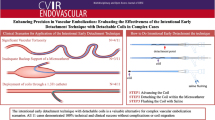Abstract
The steerable microcatheter (SwiftNINJA, Sumitomo Bakelite, Tokyo, Japan), which has a remote-controlled flexible tip manipulated using a dial in the handgrip, was recently developed and delivered to the market. This device enables the user to change the angle of the microcatheter tip manually, and potentially makes selective catheterisation easier. We evaluated its unique characteristics and utility in selective catheterisation and coil embolization. This article describes: (1) the advantages of this device in catheterisations involving acute angle branches, and (2) a new technique of compact coil packing with the use of intentional folding by the bendable tip of the catheter.




Similar content being viewed by others
References
Horikawa M, Miyayama S, Irie T, et al. Development of conventional transarterial chemoembolization for hepatocellular carcinomas in Japan: historical, strategic, and technical review. AJR Am J Roentgenol. 2015;205:764–73.
Halpenny D, Snow A, McNeill G, Torreggiani WC. The radiological diagnosis and treatment of renal angiomyolipoma—current status. Clin Radiol. 2010;65:99–108.
Dudeck O. Safety and efficacy of target vessel catheterization with the new steerable microcatheter Direxion compared with a standard microcatheter: a prospective, preclinical trial. Cardiovasc Interv Radiol. 2014;37:1041–6.
Kiyosue H, Hori Y, Matsumoto S, et al. Shapability, memory, and luminal changes in microcatheters after steam sha**: a comparison of 11 different microcatheters. AJNR Am J Neuroradiol. 2005;26:2610–6.
Miyayama S, Matsui O, Akakura Y, et al. Use of a catheter with a large side hole for selective catheterization of the inferior phrenic artery. J Vasc Interv Radiol. 2001;12:497–9.
Abdelsalam ME, Mahvash A, Avritscher R, et al. Balloon-assisted flow diversion and selective catheterization of target vessels for hepatic transarterial embolization. J Vasc Interv Radiol. 2016;27:283–5.
Sincic RS, Caton CJ, Lillaney P, et al. System architecture for a magnetically guided endovascular microcatheter. Biomed Microdevices. 2014;16:97–106.
Shimohira M, Kawai T, Hashizume T, et al. Reperfusion rates of pulmonary arteriovenous malformations after coil embolization: evaluation with time-resolved MR angiography or pulmonary angiography. J Vasc Interv Radiol. 2015;26(856–64):e1.
Yasumoto T, Osuga K, Yamamoto H, et al. Long-term outcomes of coil packing for visceral aneurysms: correlation between packing density and incidence of coil compaction or recanalization. J Vasc Interv Radiol. 2013;24:1798–807.
Cho YD, Kang HS, Kim JE, et al. Microcatheter loo** technique for coil embolization of complex configuration middle cerebral artery aneurysms. Neurosurgery. 2012;71:1185–91.
Acknowledgment
The original images in Fig. 1 A–C were provided by SUMITOMO BAKELITE CO., LTD. We declare that we have no financial relationship to the company.
Source of Funding
Yusuke Sakuhara reports grants from JSPS KAKENHI Grant-in-Aid for Scientific Research (C), which is not related to the submitted work. Daisuke Abo reports personal fees from Siemens Medical Systems, which is not related to the submitted work. Kohsuke Kudo reports grants from JSPS KAKENHI Grant-in-Aid for Scientific Research (B), personal fees from GE Healthcare, Hitachi Medical Systems, Philips Medical Systems, Siemens Medical Systems, Toshiba Medical Systems, Canon Marketing Japan, Bayer Healthcare, and Daiichi-Sankyo Healthcare, which are not related to the submitted work.
Author information
Authors and Affiliations
Corresponding author
Ethics declarations
Conflicts of Interest
Takeshi Soyama, Daisuke Yoshida, and Ryo Morita declare that they have no conflict of interest.
Ethical Approval
All procedures performed in studies involving human participants were in accordance with the ethical standards of the institutional and/or national research committee and with the 1964 Helsinki Declaration and its later amendments or comparable ethical standards.
Informed Consent
Informed consent was obtained from all individual participants included in the study.
Rights and permissions
About this article
Cite this article
Soyama, T., Yoshida, D., Sakuhara, Y. et al. The Steerable Microcatheter: A New Device for Selective Catheterisation. Cardiovasc Intervent Radiol 40, 947–952 (2017). https://doi.org/10.1007/s00270-017-1579-3
Received:
Accepted:
Published:
Issue Date:
DOI: https://doi.org/10.1007/s00270-017-1579-3




